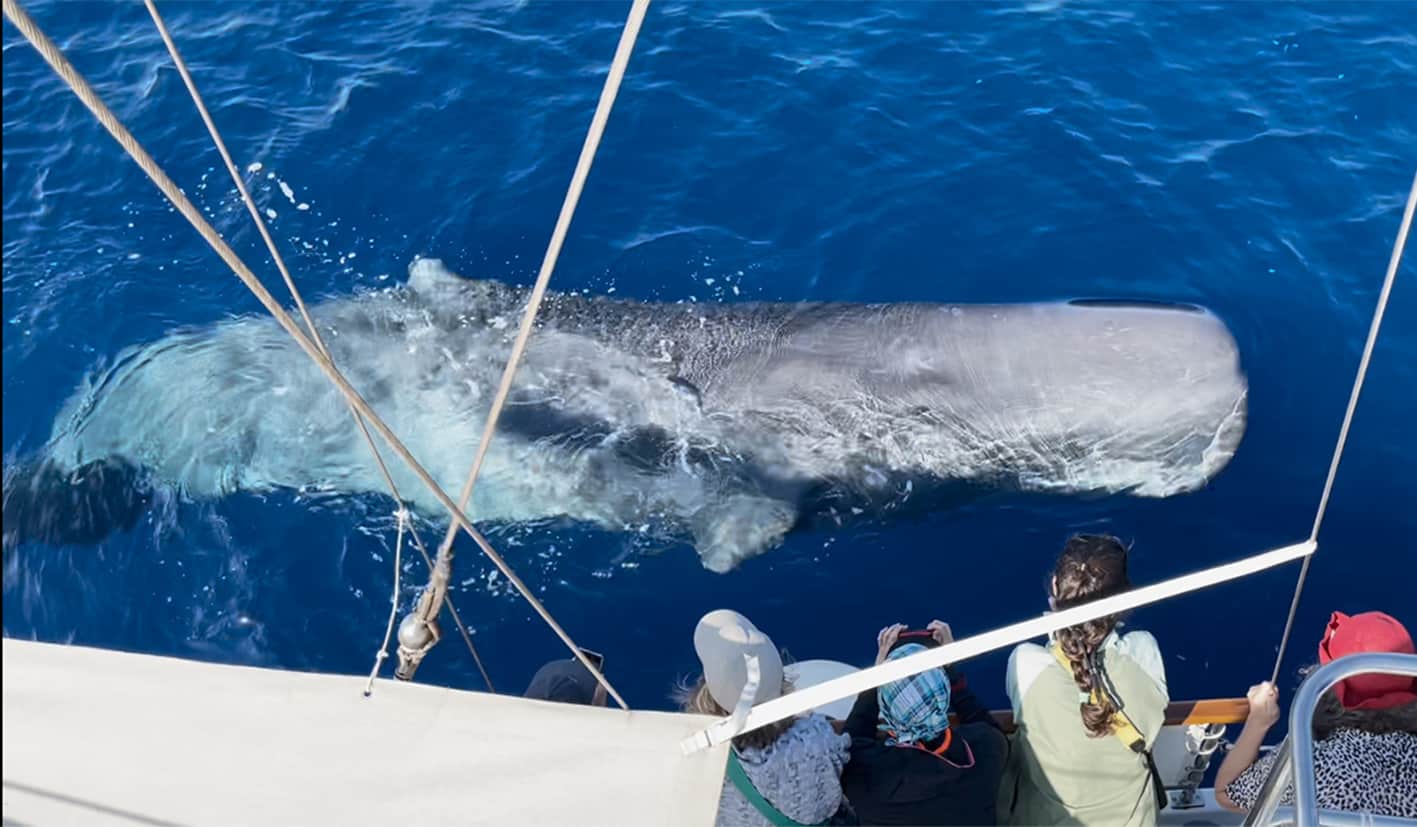Rare social group of sperm whales spotted: one ‘curious’ individual and one with an injured tail
A few days ago, the cetaceans of the Pelagos Sanctuary treated the biologists of the Tethys Institute and the participants of its citizen science programme in the Ligurian Sea to a spectacle that was not only out of the ordinary, but also of great scientific interest.
On the morning of June 6th, the researchers spotted a family group of sperm whales, the first ever encountered so early in the season by Tethys. Among them, a female with her tail conspicuously missing a piece: an alarming sign for the scientists. On the bright side, however, they also had a close encounter with a young male who approached the boat peering at the people on board, an unusual behaviour that gave everyone strong emotions.
Sperm whale named “Maude” with an injured (healed) tail
Sperm whales (Physeter macrocephalus) are among the marine mammals regularly studied as part of the Cetacean Sanctuary Research (CSR) project, which is open to the participation of the public. Usually, adult males and sub-adults are encountered in this study area, which covers about one third of the Pelagos Sanctuary, while females with their young, also known as ‘social groups’, are generally found further south. Therefore they are sighted much more rarely: Tethys has recorded four different ones since 2017. Researchers wonder if they are perhaps becoming more frequent, as this encounter would confirm. In any case, they were always sighted towards the end of the season, from late August to October. Their appearance in June could indicate an ongoing change in the population’s distribution.
The exceptional sighting also provided other important data for animal conservation: an adult female, called ‘Maude’, probably the mother of a juvenile, had a bad (healed) injury: a large ‘notch’ on the edge of her tail, most likely the fault of humans. It could be due to an accidental catch in fishing gear or a collision with a boat. The latter is one of the most dramatic problems for large cetaceans, even in the Pelagos Sanctuary, a large supra-national marine protected area in the north-western Mediterranean comprising the Ligurian, Tyrrhenian and Corsican Seas and dedicated to the protection of marine mammals.
Female sperm whale with two juveniles
“We spotted the group shortly after leaving our base at Portosole Sanremo,” say the researchers on board, Mario Gabualdi and Viola Panigada; “there were eight to nine animals, including two young with their mothers and two juveniles; although dispersed within a radius of about four miles, they were certainly individuals in contact with each other, clearly audible even through the hydrophone, the underwater microphone capable of picking up the cetaceans’ vocalisations.” The recordings, which comprise part of the sperm whales’ vast vocal repertoire, will be invaluable, combined with the photos and videos produced in collaboration with Canon, for future analysis.
“Just as we were about to move away so as not to disturb the group with the young ones, a juvenile male came alongside the boat,” says an excited Roberto Raineri, skipper of Flash Vela d’Altura’s “Pelagos”. “He stuck his head out to observe us, a behaviour known as spy-hopping, and stayed with us for about forty minutes. In all my years I had never seen anything like that.”
The excitement over the extraordinary encounter having passed, researchers are now wondering about the implications: according to a study coordinated by Tethys (*) between 15 and 18% of its sperm whales photographed and ‘catalogued’ show signs that can potentially be traced back to a collision. “The data are definitely underestimated,” points out Maddalena Jahoda, researcher and head of scientific outreach at Tethys. “Indeed, we do not know how many die without being noticed. However, the appearance of family groups, interesting as it is, is also a cause for concern. Unlike the adults, the young do not yet make long dives, but stay on the surface, even more exposed to the risk of being run over.”
A male juvenile came close to our boat and stayed with us for approx. 40 minutes
“We don’t know where and when the accident happened, but the fact is that this group was also on the freighters’ route, which in the Sanctuary coincides with the sperm whale habitat,” adds Sabina Airoldi CSR’s project director. “This is why Tethys is at the forefront of mitigating the collision problem together with other bodies and the italian Coast Guard, with which it has been collaborating for years and with which it recently signed a new memorandum of understanding*. Tethys is also a partner in the Life Seadetect project, which aims to develop new technologies to mitigate the issue of collisions between ships and cetaceans.”
In order to study sperm whale groups with calves, the Institute has also launched a fundraising campaign to conduct a winter monitoring as soon as possible.
Scientific data, on sperm whales and the other seven cetacean species in the Pelagos Sanctuary, will continue to be collected, again with the help of enthusiasts from the public, until the beginning of October; they provide a valuable basis for the protection of whales and dolphins in our seas.
Maddalena Jahoda
Funded by the Permanent Secretariat of the Pelagos Agreement
Sperm whale mother with her calf













